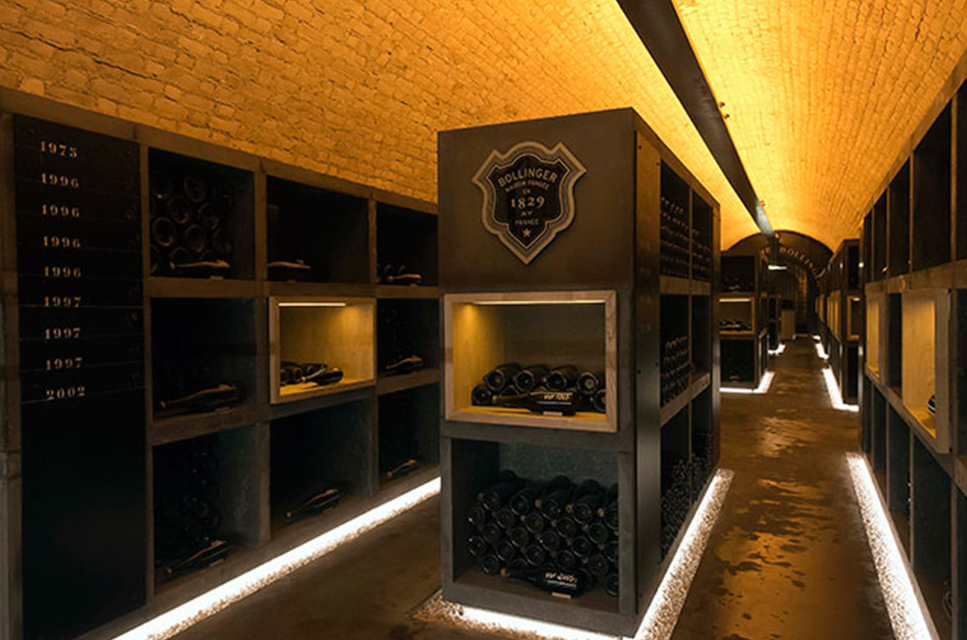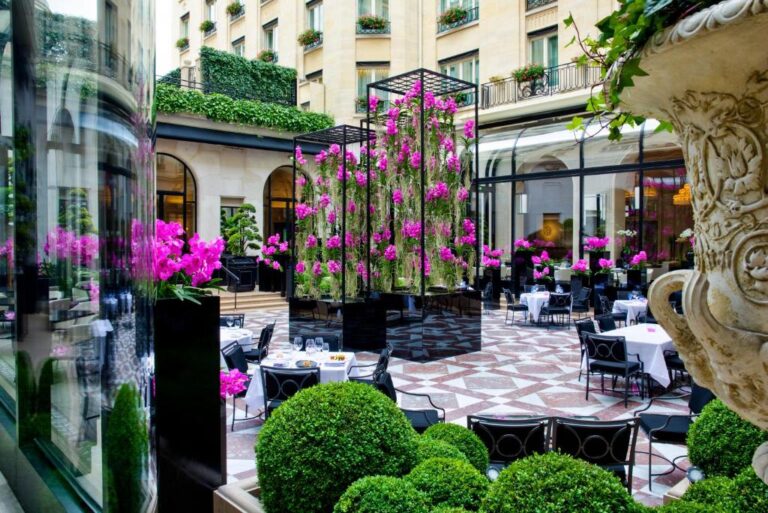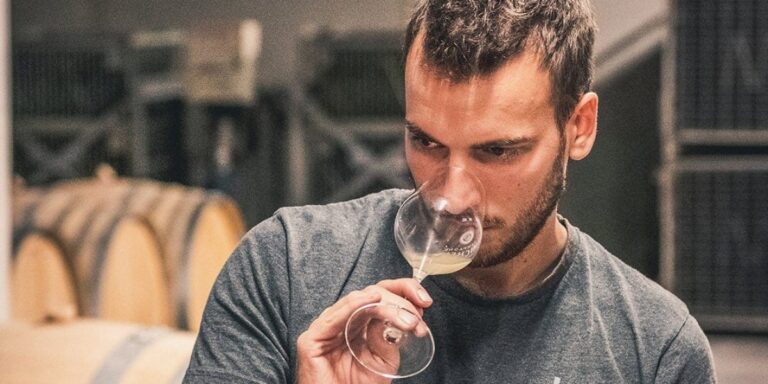Champagne, renowned for its effervescence, owes its signature bubbles to the meticulous secondary fermentation process it undergoes. [read the full champagne story]
Estimated reading time: 12 minutes

Understanding Champagne Characteristics
Champagne, renowned for its effervescence, owes its signature bubbles to the meticulous secondary fermentation process it undergoes. This produces carbon dioxide, which, when trapped in the liquid, creates the sparkle in your glass. The size and persistence of the bubbles are indicative of the champagne’s quality; finer bubbles often suggest a higher-quality beverage.
The aromas and flavors of champagne are influenced by the particular blend of grapes, including Chardonnay, Pinot Noir, and Pinot Meunier. Each grape adds its own layer to the champagne’s complexity. For example, Chardonnay contributes to the champagne’s acidity and elegance, while Pinot Noir and Pinot Meunier lend body and fuller flavors.
Champagne can either be non-vintage, blending multiple years for consistency, or vintage champagne, made from grapes harvested in a single year. Vintage bottles typically represent a producer’s finest product and exhibit unique characteristics reflective of that year’s climate and conditions.
As a symbol of luxury, champagne requires careful handling to maintain its unique properties. The way you store champagne can significantly affect these characteristics, with appropriate conditions maintaining its quality and enhancing its maturation.
Remember, whether it’s a special celebration or a personal indulgence, your appreciation for champagne will deepen as you come to understand and identify the nuances that contribute to its celebrated reputation.
Ideal Conditions for Champagne Storage
Proper champagne storage hinges on maintaining consistent temperatures and humidity levels while protecting the bottles from light and positioning them correctly.
Temperature Requirements
- Ideal Temperature: Store your champagne at a steady 12-14°C (53.6-57.2°F).
- Consistency: Avoid fluctuations, as consistent temperature prevents premature aging.
Humidity and Cork Maintenance
- Humidity Levels: Aim for 70% humidity to keep the cork moist and prevent it from drying out.
- Cork Protection: A moist cork ensures an airtight seal, safeguarding the champagne’s quality.
Light Exposure and Bottle Positioning
- Light: Shield champagne from light, especially sunlight, which can degrade quality. UV rays can prompt chemical reactions, so dark storage areas are preferable.
- Positioning: Rest bottles on their sides to keep the cork in contact with the champagne, ensuring the cork remains swollen and moist.
Short-Term vs Long-Term Storage
Proper storage is crucial for maintaining the quality and longevity of champagne. Consider your time frame for storage to select the optimal method.
Short-Term Storage Solutions
For short-term storage, keeping your champagne in the fridge is a convenient option. Your champagne should be stored upright to minimize the contact area between the champagne and the cork, which can reduce flavor transfer from the cork and prevent it from drying out. Here’s the strategy for short-term storage:
- Duration: Up to 3-5 days
- Temperature: Keep the fridge setting around 40-50°F (4-10°C)
Key Consideration: Short-term storage in a household refrigerator is only temporary as vibrations and inconsistent temperatures can affect the champagne’s quality over time.
Long-Term Storage Strategies
For long-term storage, which is anything beyond a few weeks, you need a more controlled environment such as a wine cellar or wine refrigerator. This will maintain both temperature and humidity at ideal levels to ensure your champagne ages well.
Long-Term Storage Checklist:
- Temperature: Consistent 55°F (13°C) with minimal fluctuations
- Humidity: Ideal range of 60-70%
- Orientation: Keep bottles on their side to keep the cork moist
- Light: Protect from light, especially direct sunlight
- Vibration: Minimize to prevent agitation
A cellar master can ensure these conditions are maintained in a professional setting. However, if you are storing champagne at home, consider investing in a dedicated cooling unit. The upfront cost will pay off in preserving your champagne’s proper storage conditions and its longevity.
The Debate Over Special Storage Devices
When you want to preserve your champagne’s quality, the choice of storage devices can play a pivotal role, sparking considerable debate around their utility and necessity.
Common Storage Accessories
A variety of accessories claim to aid in champagne storage after opening. These include:
- Metal Spoon: A common myth suggests that hanging a metal spoon from the neck of an open champagne bottle helps to preserve the bubbles. However, there is no scientific evidence supporting this practice.
- Hermetic Cork: Designed to provide an airtight seal, hermetic corks can effectively slow down the oxidation process that affects champagne once opened.
- Wine Stopper: Simple wine stoppers may not preserve the effervescence of champagne as effectively as specialized versions.
- Sparkling Wine Stopper: Tailored to handle the pressure of carbonated beverages, these stoppers are often considered more effective than standard wine stoppers.
- Bottle Stopper: Various bottle stoppers exist, some with vacuum-sealing capabilities to preserve the fizz and flavor of champagne for a few days.
Each accessory has its proponents and detractors, requiring you to weigh convenience against proven effectiveness.
Effectiveness and Alternatives
In comparing the effectiveness of storage devices, consider:
- Tested Efficacy: Sparkling wine stoppers with clamps or lock mechanisms that secure tightly around the bottle neck provide a strong seal, preserving the bubbles and preventing spillage.
- Storage Conditions: Even with the use of stoppers, storing your champagne in a cool, stable environment—ideally between 40-60°F (4-15°C)—is essential for maintaining quality.
- Alternatives: Refrigeration is crucial, and even without a stopper, keeping the champagne cold will slow down the oxidation process. Additionally, consuming the champagne within 1-3 days after opening often precludes the need for fancy devices.
Choosing the most appropriate storage accessories involves balancing the cost and claimed benefits with how well they actually perform in preserving champagne’s unique characteristics.
How to Store Opened Champagne
When you’ve opened a bottle of champagne but haven’t finished it, proper storage is key to maintaining its quality. Preserve the effervescence and taste of your leftover champagne by following these steps:
- Re-cork Immediately: As soon as you’ve poured your glasses, re-cork the bottle. If the original cork won’t fit, use a champagne stopper specifically designed to seal tightly and keep oxygen out.
- Minimize Oxygen Exposure: Oxygen is the enemy of fizzy champagne. Limit exposure by ensuring the stopper is securely in place right after pouring to prevent the bubbles from escaping.
- Refrigeration is Essential: Keep your opened champagne in the refrigerator to slow down oxidation. The cold temperature helps preserve the champagne’s vivacity and flavors.
- Store Upright: Unlike still wine, you should store an opened bottle of champagne upright. This minimizes the surface area exposed to oxygen and keeps the effervescence intact.
- Consume Quickly: Even with optimal storage, an opened bottle of champagne will lose its character over time. Aim to enjoy your champagne within 1-3 days after opening.
Use the following table as a quick reference for opened champagne storage practices:
| Action | Purpose | Timeframe |
|---|---|---|
| Re-cork/Stopper | Limit oxygen, preserve bubbles | Immediately after pouring |
| Refrigerate | Slow oxidation, maintain quality | Until consumed |
| Store upright | Reduce oxygen contact, keep fizzy | Continuously |
| Drink | Optimal taste and effervescence | 1-3 days after opening |
Remember, these measures won’t prevent eventual loss of quality but will help to maintain the champagne’s distinctive qualities for a short period after opening.
Mitigating Environmental Factors
Proper storage of champagne is crucial to maintain its quality and enhance aging potential. It’s important to control environmental factors that can impact your champagne, particularly vibration and temperature fluctuations.
Vibration and Stability
Your champagne should be kept in a stable environment to prevent constant vibrations. These vibrations could interfere with the aging process, as they can disturb the sediments in the bottle that contribute to the complex flavors—especially relevant for vintage champagnes.
- Prevent Vibrations:
- Ensure your storage area is away from heavy foot traffic.
- Avoid proximity to machinery or appliances that create movement, such as washing machines or heating systems.
Temperature Fluctuations
Maintaining a consistent temperature is pivotal for the preservation of champagne. Fluctuations can cause the champagne to expand and contract, potentially compromising the seal of the bottle and allowing air to seep in.
- Ideal Temperature Range: 45°F to 55°F (7°C to 13°C)
- Consistency is Key:
- Store champagne in a climate-controlled environment.
- Avoid areas where temperature varies significantly, such as near a heating system.
By minimizing exposure to vibrations and avoiding temperature fluctuations, you can help safeguard the quality of your champagne and promote favorable aging conditions.
Selecting Storage Containers and Formats
When planning to store champagne, the type and size of the container is crucial to maintain quality. Your choice will affect the wine’s surface area exposed to the aging process and require appropriate space management.
Standard Bottles Versus Magnums
Standard bottles (750ml)
- Pros: Convenient for individual consumption; faster aging process due to higher surface area to volume ratio.
- Cons: Greater susceptibility to variations in storage conditions; less ideal for long-term aging.
Magnums (1.5L)
- Pros: Reduced surface area to volume ratio, providing a slower and potentially more complex aging process; higher volume makes them impressive for events.
- Cons: Larger storage space required; less practical for casual drinking occasions.
Different Types of Champagne and Their Needs
- Prosecco: Non-traditional Champagne but popular sparkling wine; store upright due to its pressurized cork and to minimize the surface area exposed to air.
- Cava: Traditional method sparkling wine from Spain; similar in storage requirements to Champagne and benefits from horizontal storage.
- Champagne: Prefer horizontal storage, which allows the wine to maintain moisture in the cork and prevent air from entering the bottle.
Remember, the choice of bottle size and understanding the specific needs of the type of sparkling wine you possess are pivotal in preserving its desired qualities.
Avoiding Common Storage Mistakes
Proper storage of champagne is crucial to ensure its quality and longevity. Missteps can lead to harm such as cork deterioration and flavor alteration caused by light exposure. The following subsections detail preventative measures to address these concerns.
Preventing Cork Drying Out
To prevent your champagne’s cork from drying out, you should store the bottles in a horizontal position. This positioning ensures that the wine keeps the cork moist from the inside, which is especially important for champagne that you intend to age for a long time.
- Humidity: Aim for a storage environment with a humidity level of about 70% to maintain the cork’s elasticity without inviting mold.
Keep in mind that cork drying can allow air to seep into the bottle, potentially ruining the champagne. Always monitor the cork condition and the environment’s humidity.
Shielding from Harmful Light
Champagne is sensitive to light, particularly ultraviolet (UV) rays, which can cause a fault known as goût de lumière, or light strike.
- Storage Location: Select a dark place for storage, such as a cellar, to minimize the risk of light exposure. If a darkened space is not available, cover the bottles or use a storage box.
- Type of Light: Both natural and artificial lights pose risks, with the former being the most damaging. If your champagne is in a visible location, consider using incandescent bulbs or UV filters to reduce exposure.
By adhering to these practices, you can avoid common storage mistakes that might compromise the integrity of your champagne. Regularly check on your storage conditions to ensure that they remain optimal.
Maintaining Storage Conditions
To preserve the unique taste and lively bubbles of your champagne, maintaining optimal storage conditions is crucial. Here, we focus on temperature and humidity as primary factors in preventing your champagne from going flat.
Temperature: Keep your champagne at a constant temperature, ideally between 8°C and 12°C (46°F to 54°F). Fluctuations can affect the champagne’s aging process and risk compromising its quality.
- Avoid Heat: Exposure to high temperatures can cause your champagne to age prematurely.
- Prevent Chilling: Overly cold temperatures can dampen the effervescence and lead to a flat champagne.
Humidity: Aim for 70% humidity in your storage area. This level helps maintain the cork’s elasticity, ensuring a tight seal and preventing air from entering the bottle.
- Cork Condition: A dried out cork is a common culprit for flat champagne. Ensure the cork remains moist.
- Storage Position: Store bottles on their side to keep the cork in contact with the champagne.
The champagne region and its vineyards follow these principles meticulously, as they are essential in producing and storing high-quality champagne. You should replicate these conditions to enjoy champagne as intended. Remember, consistent conditions are key; your storage environment should avoid direct sunlight, strong odors, and vibration. Implement these practices to protect the taste and effervescence of your champagne for optimal enjoyment.
Tips for Building a Champagne Collection
When embarking on building your champagne collection, consider selecting a range of styles to enjoy their spectrum of textures and to pair with various foods. A good mix might include:
- Non-vintage Brut: For a vibrant, go-to choice.
- Vintage: To experience the complexity developed through aging.
- Rosé: For a touch of color and variety.
Keep in mind that proper storage is key to preventing premature aging and oxidation. Follow these guidelines to maintain your collection:
- Constant, Moderate Temperature: Aim for storage at 45-55°F (7-13°C). Severe temperature fluctuations can damage champagne.
- Humidity Control: A level of 60-70% will keep corks from drying out.
- Stable Environment: Avoid vibrations that might disrupt the aging process.
Home storage solutions range from wine refrigerators to a dedicated cellar. If neither is feasible, a cool basement corner away from light may suffice.
Remember:
- Store bottles horizontally to keep corks moist.
- Minimize exposure to light, especially direct sunlight.
- Open bottles carefully to preserve quality – avoid popping the cork.
By adhering to these tips, you can ensure your champagne collection remains in optimal condition, making every occasion to indulge truly special.
Frequently Asked Questions
Properly storing Champagne ensures you enjoy its full quality. Specific temperatures and positions affect its preservation.
What is the ideal temperature range for storing Champagne to maintain its quality?
Your Champagne should be stored at a consistent temperature between 45°F and 65°F (7°C and 18°C), with 55°F (13°C) being the optimal point.
What is the recommended position for storing Champagne bottles, upright or horizontally?
To maintain the cork’s moisture and ensure a proper seal, store your Champagne bottles horizontally.
For optimal preservation, should Champagne be stored in the refrigerator or at room temperature?
For long-term storage, place your Champagne in a wine cellar or other cool, dark place at room temperature. The refrigerator is suitable for short-term storage only.
What is the maximum duration for keeping an unopened bottle of Champagne without compromising its taste?
Champagne can generally be stored unopened for 3 to 4 years if non-vintage and 5 to 10 years if vintage, ensuring its quality and taste.
Can Champagne be stored on its side in the refrigerator, and if so, are there any special considerations to be aware of?
Yes, storing Champagne on its side in the refrigerator is acceptable for short periods. However, ensure it is away from light and vibration, and keep the temperature stable.
Once opened, is there a method to keep Champagne fresh and bubbly?
After opening, reseal your Champagne with a specialized stopper and refrigerate it to slow down the loss of carbonation. Consume within 1 to 3 days.





